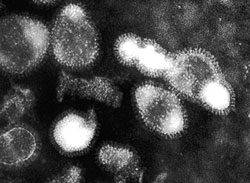Influenza isn’t an exclusively human disease. Many other creatures have their own versions of it, most significantly waterfowl like ducks and geese. But all the various versions of influenza are similar enough that they can sidestep from one species to another, sharing genetic information as they go, thereby giving rise to new variations capable of being handed on further; ducks to chickens, for example, chickens to pigs, to cats, to humans.
This variability also means that the influenza virus is hard for the human immune system to deal with. Exposure to a given strain of influenza renders survivors more or less immune to further infection—by that strain. But influenza’s constant variability affects the very capsule compounds the virus uses to enter human cells. One such compound comes in 16 different flavors, the other in nine; hence immunologists’ characterization of flu strains by the abbreviation HxNy. If you have acquired immunity to H1N1 (the commonest strain in the world today), you still may be vulnerable to H3N2.
The annual flu shot recommended for the most vulnerable segments of society is made to confer resistance to the three strains that world health authorities decide each spring are the most likely to be active the following winter. But the actual mix of strains may not match the authorities’ best guess, leaving many populations unprepared for an unexpectedly resurgent strain. And the system breaks down completely when a completely new strain appears.
Once it manages to get into a victim’s lungs, the influenza virus attaches itself to mucus membranes, enters cells, and takes over their DNA, forcing the cell to manufacture new virus particles that are released into the lungs. An infected person is infectious to others before any symptoms appear. No sneezing is necessary—just touching nose, mouth, or eyes will seed the hands with virus that will be deposited on any surface touched thereafter.
Two things determine the seriousness of a flu epidemic: communicability (some strains pass from human to human more easily than others) and virulence. Virulent strains are more aggressive—sometimes so aggressive that the afflicted individual’s body panics and goes into immunologic overdrive, flooding the lungs with disease-fighting cells looking vainly for their prey. Victims of the most virulent strains of flu don’t die from the disease itself or subsequent infections like pneumonia; their lungs are smothered by the body’s own attempt to fight back.








